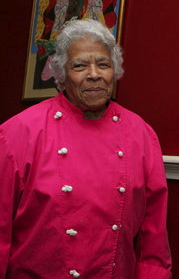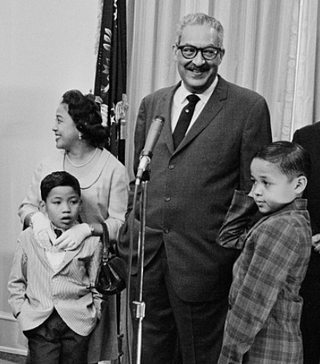
African-American art is a broad term describing visual art created by African Americans. The range of art they have created, and are continuing to create, over more than two centuries is as varied as the artists themselves. Some have drawn on cultural traditions in Africa, and other parts of the world where the Black diaspora is found, for inspiration. Others have found inspiration in traditional African-American plastic art forms, including basket weaving, pottery, quilting, woodcarving and painting, all of which are sometimes classified as "handicrafts" or "folk art".
Wyatt Tee Walker was an African-American pastor, national civil rights leader, theologian, and cultural historian. He was a chief of staff for Martin Luther King Jr., and in 1958 became an early board member of the Southern Christian Leadership Conference (SCLC). He helped found a Congress for Racial Equality (CORE) chapter in 1958. As executive director of the SCLC from 1960 to 1964, Walker helped to bring the group to national prominence. Walker sat at the feet of his mentor, BG Crawley, who was a Baptist Minister in Brooklyn, NY and New York State Judge.

The Greensboro sit-ins were a series of nonviolent protests in February to July 1960, primarily in the Woolworth store—now the International Civil Rights Center and Museum—in Greensboro, North Carolina, which led to the F. W. Woolworth Company department store chain removing its policy of racial segregation in the Southern United States. While not the first sit-in of the civil rights movement, the Greensboro sit-ins were an instrumental action, and also the best-known sit-ins of the civil rights movement. They are considered a catalyst to the subsequent sit-in movement, in which 70,000 people participated. This sit-in was a contributing factor in the formation of the Student Nonviolent Coordinating Committee (SNCC).

Leyah (Leah) Chase was an American chef based in New Orleans, Louisiana. An author and television personality, she was known as the Queen of Creole Cuisine, advocating both African-American art and Creole cooking. Her restaurant, Dooky Chase, was known as a gathering place during the 1960s among many who participated in the Civil Rights Movement, and was known as a gallery due to its extensive African-American art collection. In 2018 it was named one of the 40 most important restaurants of the past 40 years by Food & Wine.

The African American Museum in Philadelphia (AAMP) is notable as the first museum funded and built by a municipality to help preserve, interpret and exhibit the heritage of African Americans. Opened during the 1976 Bicentennial celebrations, the AAMP is located in historic Philadelphia on Arch Street, a few blocks away from the Liberty Bell. It was formerly known as the Afro-American Historical and Cultural Museum.
Xernona Clayton Brady is an American civil rights leader and broadcasting executive. During the Civil Rights Movement, she worked for the National Urban League and Southern Christian Leadership Conference, where she became involved in the work of Dr. Martin Luther King Jr. Later, Clayton went into television, where she became the first African American from the southern United States to host a daily prime time talk show. She became corporate vice president for Turner Broadcasting.

The Harlem Renaissance was an intellectual and cultural revival of African-American music, dance, art, fashion, literature, theater, politics and scholarship centered in Harlem, Manhattan, New York City, spanning the 1920s and 1930s. At the time, it was known as the "New Negro Movement", named after The New Negro, a 1925 anthology edited by Alain Locke. The movement also included the new African-American cultural expressions across the urban areas in the Northeast and Midwest United States affected by a renewed militancy in the general struggle for civil rights, combined with the Great Migration of African-American workers fleeing the racist conditions of the Jim Crow Deep South, as Harlem was the final destination of the largest number of those who migrated north.
The civil rights movement in Omaha, Nebraska, has roots that extend back until at least 1912. With a history of racial tension that starts before the founding of the city, Omaha has been the home of numerous overt efforts related to securing civil rights for African Americans since at least the 1870s.

Lucy Craft Laney was an American educator who in 1883 founded the first school for black children in Augusta, Georgia. She was principal for 50 years of the Haines Institute for Industrial and Normal Education.
Ralph Mark Gilbert was an American civil rights leader and a Baptist minister.
Jibreel Khazan is a civil rights activist who is best known as a member of the Greensboro Four, a group of African American college students who, on February 1, 1960, sat down at a segregated Woolworth's lunch counter in downtown Greensboro, North Carolina challenging the store's policy of denying service to non-white customers. The protests and the subsequent events were major milestones in the Civil Rights Movement.

Augusta, Georgia was founded in 1736 as part of the British colony of Georgia, under the supervision of colony founder James Oglethorpe. It was the colony's second established town, after Savannah. Today, Augusta is the second-largest city in Georgia, and the largest city of the Central Savannah River Area.
Aberjhani is an American historian, columnist, novelist, poet, artist, and editor. Although well known for his blog articles on literature and politics, he is perhaps best known as co-author of Encyclopedia of the Harlem Renaissance and author of The River of Winged Dreams. The encyclopedia won a Choice Academic Title Award in 2004.

Betsy Graves Reyneau (1888–1964) was an American painter, best known for a series of paintings of prominent African Americans for the exhibition “Portraits of Outstanding Americans of Negro Origin” that, with those by Laura Wheeler Waring and under the Harmon Foundation, toured the United States from 1944 to 1954. A granddaughter of Michigan Supreme Court Justice Benjamin F. Graves, Reyneau's sitters included Mary McLeod Bethune, George Washington Carver, Joe Louis, and Thurgood Marshall. Reyneau's portrait of Carver, the most famous, was the first of an African American to enter a national American collection.

Louise Daniel Hutchinson was an American historian. She was the former Director of the Research at the Anacostia Community Museum. Growing up in Washington, D.C., Hutchinson was exposed to the Civil Rights Movement and the importance of community. Hutchinson worked closely with the African American community of Washington, D.C., and staff at the Smithsonian Institution to help build the Anacostia Community Museum. She was a historian of the Anacostia community.
The history of the 1954 to 1968 American civil rights movement has been depicted and documented in film, song, theater, television, and the visual arts. These presentations add to and maintain cultural awareness and understanding of the goals, tactics, and accomplishments of the people who organized and participated in this nonviolent movement.

Robert H. McNeill was an American photographer who documented African-American life. "In the 1930s and 40s, any time there was a political, social, religious or community event in Washington's black community, Robert H. McNeill was there to photograph it."

Cecilia Suyat Marshall was an American civil rights activist and historian from Hawaii who was married to Thurgood Marshall, the first African-American U.S. Supreme Court Justice, from 1955 until his death in 1993. She was of Filipino descent. Her life is featured in the National Museum of African American History and Culture at the Smithsonian and she was recorded by the Library of Congress regarding her experiences with civil rights in the United States. In the 1940s and 1950s, she served as a stenographer and private secretary for the NAACP in Washington, D.C.
William Thacker McBride Jr. was an African-American artist, designer and collector. McBride began his career in the 1930s in the circles of black art collectives and artistic opportunities afforded by the Works Progress Administration. He would ultimately leave his mark in Chicago as a driving force behind the South Side Community Art Center. McBride distinguished himself as a teacher, as a cultural and political activist, and as a collector of African art and artwork by black artists of his generation.











